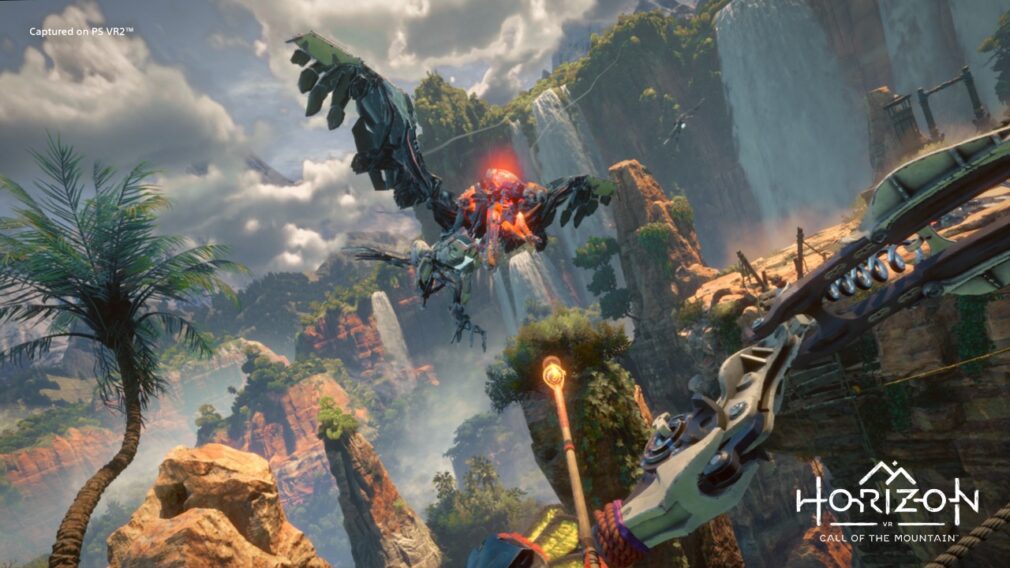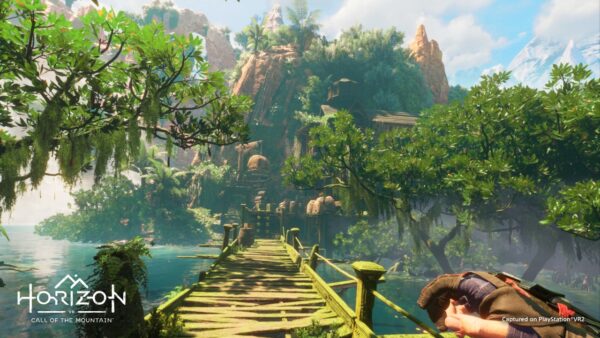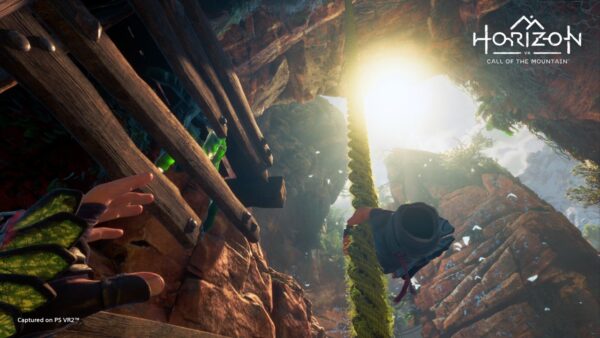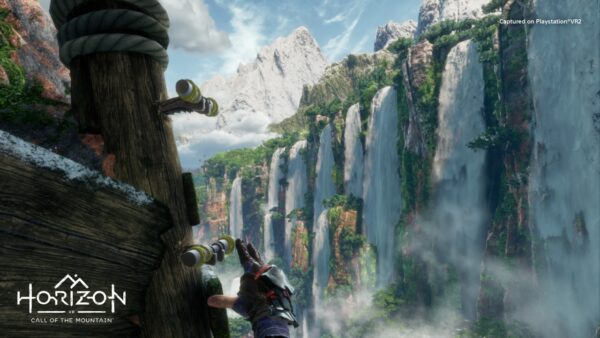Publisher: PlayStation Studios
Developer: Firesprite/Guerilla Games
Medium: Digital
Players: 1
Online: No
ESRB: T
Every new gaming platform needs a system seller or killer app of some sort and that most certainly extends to a pricey new piece of virtual reality hardware for a popular existing console. In this case we?re talking about Horizon: Call of the Mountain for the newly released PlayStation VR2. Valve kinda put the Steam VR platform on the map thanks to Half Life: Alyx, and in my eyes, Sony and Firesprite/Guerrilla Games have definitively accomplished the same goal with Horizon: Call of the Mountain for the PS VR2. If you?re looking for a well-rounded, visually impressive, high quality VR game experience for your new PlayStation VR2 hardware, Call of the Mountain is easily a must have launch title.
Sony?s Firesprite studio has some experience with VR and experimental augmented reality type of applications, and had a hand in the development of the original The Playroom and The Playroom VR for the PS4 which utilized the PlayStation Camera and the original PlayStation VR respectively. So developing Horizon: Call of the Mountain in conjunction with Guerrilla made sense on paper — and after playing through the finished product, in the practical real-world sense as well.
Horizon: Call of the Mountain is a virtual reality adventure title set in the Horizon universe and not just an excuse to show off each and every feature the PlayStation VR2 has to offer — although it does that too. VR is supposed to put you, the player, right in the middle of the experience and that?s Call of the Mountain?s biggest success. Whether you?re talking to NPCs face-to-face, scaling a mountain or some ancient structure, stealthily navigating through foliage, or whipping out a bow to take down some aggressive machines, you (as character, ex-Carja soldier Ryas), are there. The visuals and audio are all-enveloping and it?s quite easy to get lost in the world of Call of the Mountain for longer VR gaming sessions than recommended.
The visuals are gorgeous and the world is packed with graphical flourishes and impressive details all around, and the ability of the PS5 to smoothly render these quality visuals in VR was unexpected to be honest. There?s surely some magic happening with the PS VR2 technology to produce such astounding results, including foveated rendering and eye tracking. The HDR-capable eye displays are put to great use when showing off all sorts of advanced lighting scenarios and effects, and it?s difficult to not just stand around and marvel at the overall attention to detail. I definitely muttered ?wow? or ?holy shit? to myself more than a few times.
My tolerance for VR, in general, is sort of in the middle. Certain games do give me a bit of motion sickness depending on the comfort settings and movement options but Horizon: Call of the Mountain does a great job all but eliminating that issue thanks to some nice quality of life features. The ?comfort? movement/walking scheme, which has you hold a button on each VR2 Sense controller, while sort of mimicking a walking motion with your arms is one of my favorite yet. I put in hours long sessions when playing through the game, and there were times that I should have taken more frequent breaks (as is recommended), though that?s up to each player. Horizon: Call of the Mountain does have more than a few accessibility features and gameplay options, and can accommodate seated, standing and roomscale gameplay, so pretty much anyone can partake in the adventure. I opted for roomscale and most definitely breached the boundaries a few times during some of the more complex traversal sequences and action-heavy enemy encounters.
With ?Mountain? in the title and the main character being adept at climbing as part of his backstory you would assume there would be some climbing gameplay in the game — and that?s definitely the case here. I?d say that more than 50% of Horizon VR requires some climbing activities, sometimes taking upwards of 15 minutes at a time. The levels are designed with verticality in mind, so pretty much every tall structure in the world ends up requiring to be scaled in some way — from free climbing bare-handed, to utilizing climbing axes and various grappling tools. The VR2 Sense controllers are put to amazing use as the adaptive triggers provide appropriate tactile tension when ?grabbing? scalable parts of the various structures. It?s a weird sensation at first, but by the end of the game I was racing up tall climbs like an Olympic athlete. And what goes up must come down of course, so there are some also impressive ziplines or scenic elevator rides back down. There?s definitely no shortage of shoulder-burning motions during the experience; The game can be a bit of a workout at times and I certainly broke a sweat on a few occasions.
Horizon: Call of the Mountain is a linear story-driven game, so you are not spending countless hours wandering around open-world environments (thankfully). In terms of story, each chapter has Ryas working on a various quest to help find his brother and understand why some machines are beginning to terrorize some settlements. Along the way you?ll bump into some familiar characters (Aloy makes a cameo of course), and there are some simple dialog trees but nothing anywhere near what you?ll find in the mainline Horizon titles. Each level has some climbing, some puzzle solving, some action and a dash of optional exploration, and even a dramatic boss fight on occasion. Speaking of combat there?s not much hunting of machines in the typical Horizon sense, instead it?s more of forced encounters, sometimes with the opportunity to utilize stealth, but usually it?s craft some arrows, circle around the environment, and let arrows fly.
There?s some technique and strategy required, like dodging and defending, grabbing health fruit to munch on and ?wiping? away status effects, though generally the encounters are pretty straightforward — and sometimes chaotic. The secondary Sling weapon which you craft at one point is fairly useless overall, and the game could have benefitted from some more interesting enemy encounters to break up the climbing and traversal, some of which is introduced in an earlier chapter but not really expanded upon. The first person bow shooting gameplay is excellent though and you can easily reach back, pluck the bow off your back with one hand, an arrow from your quiver with the other, and pop off arrows with impressive speed and accuracy in no time.
The adventure itself lasts several hours and there?s some replayability in there as well, such as building cairns, finding artifacts, performing legendary climbs, racing through a training course and lighting beacons, to name a few. There?s also an on-rails riverboat ride mode made to basically show off the game and PS VR2 tech to friends/family.
Although I never had an issue with it, one criticism of the Horizon games in general is how chatty the main character?s inner dialog is. Like Aloy, Ryas also has a lot to say, and honestly it?s a pretty useful part of the experience when the next objective or action may not be immediately obvious. The sound design in general, from the excellent music to the 3D audio effects are crazy good and are an important part of the journey.
It should be pretty obvious by now if you?re taking the plunge and picking up a PlayStation VR2, Horizon: Call of the Mountain is a must have launch game. It could do a couple of things better, though overall it?s an impressive, well-rounded showcase of the technology and yet another solid adventure in the Horizon universe worth taking.
Note: Sony provided us with a Horizon: Call of the Mountain PS VR2 code for review purposes.






